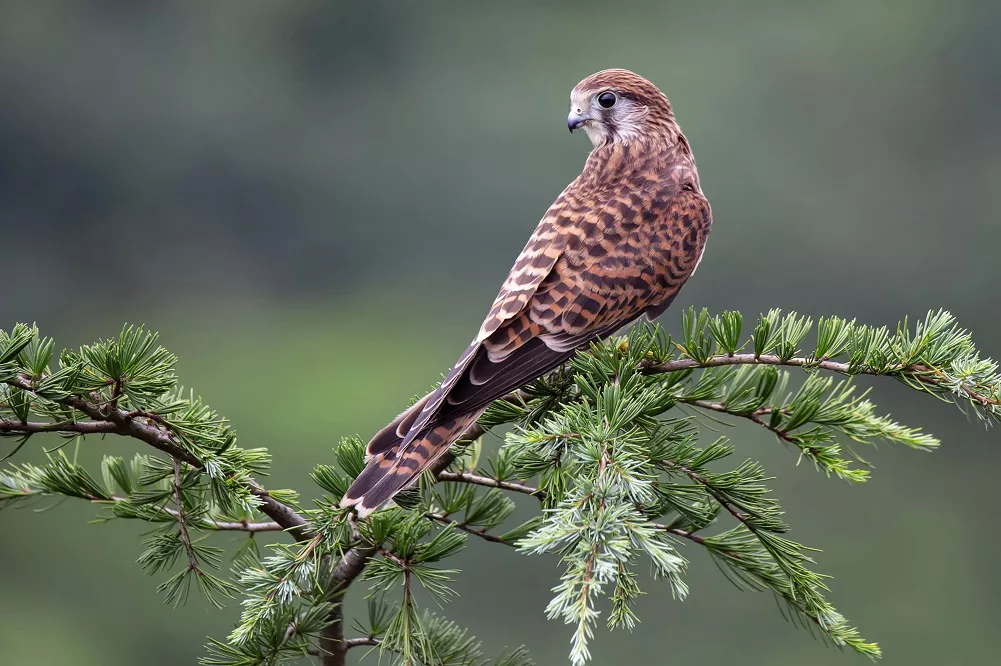The Common kestrel (Falco tinnunculus) is a small bird of prey species belonging to the kestrel group of the falcon family Falconidae. It is also known as the European kestrel, Eurasian kestrel, or Old World kestrel. In the United Kingdom, where no other Kestrel species commonly occurs, it is generally just called “kestrel”.
What does Common Kestrel look like
The top of the male kestrel’s head, the side of the head, the back of the neck, and the side of the neck are blue-gray, with slender black feather lines; the forehead, eyes, and narrow eyebrow lines are brownish-white. The back, shoulders and wing coverts are brick red with approximately triangular black spots; the waist and tail coverts are blue gray with slender dark taupe feathers. Tail blue-gray, with broad black secondary terminal spots and narrow white terminal spots; wing primary coverts and flight feathers dark brown, with light gray-brown terminal margins; primary flight feathers with white transverse spots, slightly dotted with brown markings ; The third-level flight feathers are brick red, with a wide black longitudinal stripe running vertically down the corner of the mouth. Chin, throat milky white or brownish white, chest, abdomen and two flanks brownish yellow or creamy yellow, chest and upper abdomen with dark brown fine longitudinal stripes, lower abdomen and two flanks with dark brown sagittal or drop-shaped spots, leg feathers and tail covered The lower coverts are light brown or brownish white, the underside of the tail feathers are silvery gray, the skins of the underwing coverts and axillary feathers are yellowish white or light yellowish brown, with brown dotted horizontal spots, and the underside of the flight feathers are white, densely covered with black horizontal spots.
The upper part of the female bird is brownish red, with thick dark brown feathers from the top of the head to the back of the neck and the side of the neck; the upper cover feathers from the back to the tail have thick dark brown horizontal spots; the tail is also brownish red, with 9-12 black streaks Transverse spots and broad black secondary terminal spots with brownish-yellow-white tips; wing coverts and back are both brownish-yellow, primary coverts and flight feathers are dark brown, with narrow brownish-red terminal spots; flight feathers have white transverse spots Spots, slightly dotted with brown; cheeks and mustache lines under the eyes are dark brown. The underparts are creamy yellow slightly stained with brown, the chest, abdomen and two flanks have dark brown longitudinal stripes, the leg feathers and undertail coverts are milky white, the underwing feathers and axillary feathers are light brownish yellow, densely covered with dark brown spots, flight feathers and tail feathers Below grayish white, densely covered with dark brown horizontal spots.
Juveniles resemble females, but with thicker markings on the upper body.
The iris is dark brown, the mouth is blue-gray, the apex is black, the base is yellow, the cere and eyelids are yellow, the feet and toes are dark yellow, and the claws are black.
The beak is short, with tooth processes on both sides of the apex, and the base is not covered with cereus or beard-like feathers; the nostrils are round, and a columnar bony stick can be seen inward from the nostrils; the wings are long and narrow, and the flapping rhythm is fast; the tail is relatively slender .
Common Kestrel habitat
Habitat in montane forests, forest tundra, low mountains and hills, grasslands, wilderness, forest plains, mixed forests with sparse vegetation in mountains, reclaimed cultivated land, wilderness shrub grasslands, forest margins, forest glades, sparse forests and wildernesses with sparse trees , valleys and farmland areas.
Common Kestrel behavior
Usually like to be alone, especially in the evening when the most active. It has strong flying ability, likes to fly against the wind, and can quickly flap its wings and stop in the air. It has quick eyesight and fast feeding. When it sees food on the ground, it will quickly swoop to catch it. It can also catch small birds and dragonflies in the air.
Common Kestrel often hovers in the air, searching for small vertebrates such as mice, passerines, frogs, lizards, squirrels, and snakes on the ground, and also eats insects such as locusts, grasshoppers, and crickets. During the day, the kestrel hunts mainly in the air, or flies in the air against the wind, or flies at low altitudes to search for prey. It often flaps its wings and stays in the air for a short time to observe the prey. Once the target is locked, it folds its wings and dives down to the prey , and then suddenly flew up from the ground and quickly rose to high altitude. Sometimes it stands on the high place of the cliff rock, or stands on the top of the tree and waits on the pole, and pounces on the prey when it appears.
Distribution area of Common Kestrel
This species occurs over a large range. It is widespread in Europe, Asia, and Africa, as well as occasionally reaching the east coast of North America.


 Facebook
Facebook  Instagram
Instagram  Youtube
Youtube 